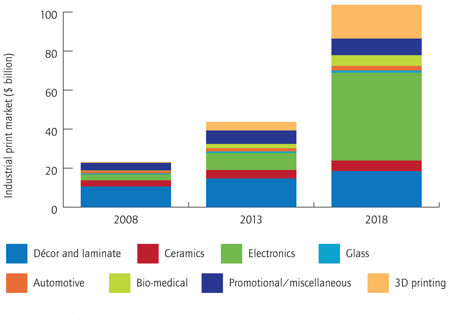Global security printing will grow at a CAGR (compound annual growth rate) of 6.3% for the ten-year period between 2013 and 2018, divided into a 6.7% CAGR for 2008-13 and 5.9% for 2013-18 according to a new market report by Smithers Pira.
The Future of Global Security Printing to 2018 contains an in-depth five year forecast of this fast-moving market. The report examines key conditions driving and prohibiting past and future growth across nine technology categories, five end-use markets and eight geographic regions.
The Future of Global Security Printing to 2018 contains an in-depth five year forecast of this fast-moving market. The report examines key conditions driving and prohibiting past and future growth across nine technology categories, five end-use markets and eight geographic regions.
Counterfeiting continues to affect society at an alarming rate - criminal organisations, petty criminals and amateur forgers unabatedly attempt and succeed in the trade of producing fake ID documents, passing counterfeit bank notes, invading supply chains with altered goods and packaging, and illegally copying tax stamps. Security printing, along with law enforcement, helps to deter counterfeiters and detect forgeries, but is increasingly affected by the digitisation of society and products.
According to the report, digitisation and convergence are two megatrends that the security printing industry needs to come to terms with. They can be seen as a threat jeopardising the very existence of the industry, or as an opportunity to innovate and evolve in order to address risk in a broader context. In the near foreseeable future, however, security printing will continue to fulfil its critical role of preventing and detecting alterations, forgeries and copies, and support product authenticity.
In geographical terms, Asia represented almost 50% of the global market for security printing in 2013, according to The Future of Security Printing to 2018. This is hardly surprising, as the region holds over 55% of the global population. Western Europe, Eastern Europe and both of the Americas each held 10% or just under.
Figure E.6 Global market for security printing by region, 2013 (%)

Source: Smithers Pira
Figure E.7 Global marker for security printing by region, 2018 (%)

Source: Smithers Pira
Western Europe, North America and Australia - arguably the most industrialised regions, were most impacted by the global financial crisis in 2008-13, but are also predicted to be rebound the strongest in the years from 2013-2018. The growth rate for each of these regions is at least twice as high in 2013-18, than what it was during 2008-13.
The study states that security printing growth in the financial end-use market will slow down to a CAGR of 5.5% as the use of cash worldwide decreases, either by consumer-driven substitution to other forms of payment, or by government-driven incentives. The Personal ID end-use market shows the largest decrease in growth, from an 8% CAGR in the 2008-13 period to a mere 3% CAGR for 2013-18. Even though National ID projects will still take place from 2013-18, the number is expected to be smaller than in the previous five years, and ePassport projects have shifted to maintenance mode. High growth is projected for the Brand Protection end-use market as a result of recently published ISO standards for security features and worldwide legislation mandating various forms of ePedigrees.
The Future of Security Printing to 2018 is available now for £3,950. To find out more about the report and how your company can benefit from a global usage licence, please contact: Heather Adams (US) T: +1 207 781 9632 or Bill Allen (UK) T: +44 (0)1372 802086.









.gif)